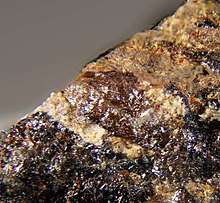Jinshajiangite
Jinshajiangite is a rare silicate mineral named after the Jinshajiang river in China.[3][2] Its currently accepted formula is BaNaFe4Ti2(Si2O7)2O2(OH)2F.[4] It gives a name of the jinshajiangite group.[2] The mineral is associated with alkaline rocks. In jinshajiangite, there is a potassium-to-barium, calcium-to-sodium, manganese-to-iron and iron-to-titanium diadochy substitution. Jinshajiangite is the iron-analogue of surkhobite[4] and perraultite.[5] It is chemically related to bafertisite, cámaraite[2] and emmerichite.[6] Its structure is related to that of bafertisite. Jinshajiangite is a titanosilicate with heteropolyhedral HOH layers, where the H-layer is a mixed tetrahedral-octahedral layer, and the O-layer is simply octahedral.[4]
| Jinshajiangite | |
|---|---|
 | |
| General | |
| Category | Sorosilicate |
| Formula (repeating unit) | BaNaFe4Ti2(Si2O7)2O2(OH)2F |
| Strunz classification | 9.BE.67 |
| Crystal system | Monoclinic |
| Crystal class | Prismatic (2/m) (same H-M symbol) |
| Space group | C2/m |
| Unit cell | a = 10.6785, b = 13.786 c = 20.700 [Å], β = 94.937° |
| Identification | |
| References | [1][2] |
The mineral has only two known places of natural occurrences; a dyke near Jinshajiang River, Sichuan Province and the intrusion of Norra Kärr in Sweden.[7][4]
References
- Sokolova E, Camara F, Hawthorne F C, Abdu Y (2009). "From structure topology to chemical composition. VII. Titanium silicates: the crystal structure and crystal chemistry of jinshajiangite". European Journal of Mineralogy. 21: 871–883. doi:10.1127/0935-1221/2009/0021-1945.CS1 maint: uses authors parameter (link)
- Mindat
- Hong, W., and Fu, P., 1982. Jinshajiangite - a new Ba-Mn-Fe-Ti-bearing silicate mineral. Geochemistry 1, 458-464
- Rastsvetaeva, R.K.; Chukanov, N.V.; Rozenberg, K.A. (2008). "Crystal Structure of Jinshajiangite from the Norra Kärr Complex (Sweden)" (PDF). Crystallography Reports. 53 (4): 553–556. doi:10.1134/s1063774508040044.
- Mindat, Perraultite
- Mindat, Emmerichite
- Holtstam, Dan (1998). "Jinshajiangite from the Norra Kärr alkaline intrusion, Jönköping, Sweden". GFF. 120 (4): 373–374. doi:10.1080/11035899801204373.